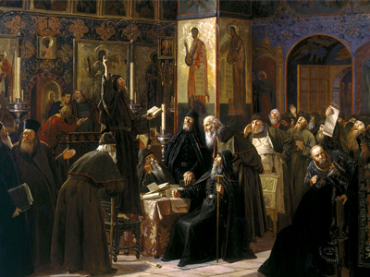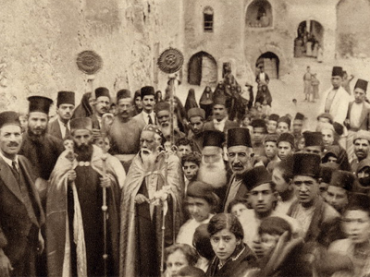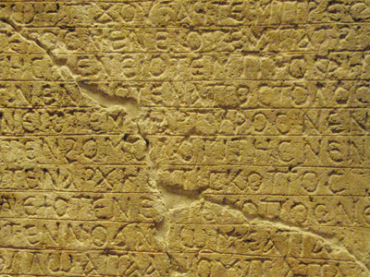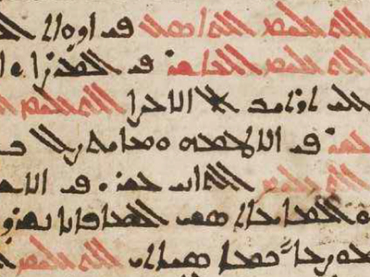Syriac and Eastern Christianity
Das Hexaëmeron des Pseudo-Ephiphanius
Series: Analecta Gorgiana 452
ISBN: 978-1-60724-886-6
August Haffner provides a critique of Ernst Trumpp’s use of the Ethiopic and Arabic sources used in his publication of the Hexamaron of Pseudo-Ephiphanius.
$42.00
Zwei nestorianische Hymnen über die Magier
Edited and Translated by Adolf Rücker
Series: Analecta Gorgiana 453
ISBN: 978-1-60724-887-3
Adolf Rücker publishes here the Syriac text and German translation of two poems about the Magi from the “Nestorian” Syriac tradition and discusses the unique features of the Magi narrative present in the Syriac sources.
$36.00
Sixth-Century Fragments of an East-Syrian Anaphora
Edited and Translated by R. H. Connolly
Series: Analecta Gorgiana 454
ISBN: 978-1-60724-888-0
Although this fragmentary Eastern Syriac Anaphora was previously published by G. Bickell, R.H. Connolly disagreed with several editorial and conjectural decisions. Thus, Connolly publishes here his own edited version of the text accompanied by a Latin translation and extended notes.
$37.00
Drei Begräbnisgersänge Narsais
Edited and Translated by Maternus Wolff
Series: Analecta Gorgiana 455
ISBN: 978-1-60724-889-7
P. Maternus Wolff publishes here the Syriac text and German translation of three burial hymns by Narsai that were originally included in an unfinished work by Karl Macke. Wolff also includes an introduction and a critical apparatus for the text.
$37.00
Sindban, oder die sieben weisen Meister
Syrisch und Deutsch
Edited and Translated by Friedrich Baethgen
Series: Analecta Gorgiana 456
ISBN: 978-1-60724-894-1
This volume is Baethgen’s dissertation from the University of Leipzig, in which he presents the Syriac text, based on the only manuscript of the work (from Berlin), along with an annotated German translation and an introduction.
$45.00
De dialectorum linguae Syriacae reliquiis
Evidence for Syriac Dialects
By F. Larsow
Series: Analecta Gorgiana 457
ISBN: 978-1-60724-895-8
In this brief work, Larsow discusses the evidence for Syriac dialects, other than the well-known eastern and western varieties, and he especially makes use of material from the lexica of Bar Ali and Bar Bahlul.
$37.00
L'Omelia di Giacomo di Sarûg sul Battesimo di Costantino Imperatore
Edited and Translated by Arthur L. Frothingham
Series: Analecta Gorgiana 458
ISBN: 978-1-60724-896-5
Frothingham here offers the Syriac text, with an annotated Italian translation, of Jacob of Sarug’s homily on the Baptism of Constantine (832 lines), based chiefly two manuscripts, one from the Vatican and the other from the British Museum.
$51.00
The Homilies of Aphraates, The Persian Sage
Edited from Syriac Manuscripts of the Fifth and Sixth Centuries in the British Museum
Edited with an Introduction by William Wright
Series: Syriac Studies Library 38
ISBN: 978-1-60724-897-2
Wright’s edition of the homilies of the early Syriac father, Aphrahat, includes the text, critical apparatus, and notes on biblical citations, which are also indexed. The preface surveys Aphrahat’s life and deals with the manuscripts used.
$248.00
History of Martyrs in Palestine, by Eusebius, Bishop of Caesarea
Discovered in a Very Ancient Syriac Manuscript
Edited and Translated by William Cureton
Series: Syriac Studies Library 39
ISBN: 978-1-60724-898-9
This volume contains the Syriac version, with English translation and copious literary and historical notes, of Eusebius’s small book on the martyrs of Palestine, edited from a Syriac manuscript dated to 411.
$163.00
Thesaurus Arabico-Syro-Latinus
Classified Vocabulary in Arabic, Syriac, and Latin
Compiled by Tommaso Obicini; Contribution by Marcus Bovelius Lucensis
Series: Syriac Studies Library 40
ISBN: 978-1-60724-899-6
The Franciscan Tommaso Obicini (1585-1632) was an early pioneer of Oriental studies. This large volume of his is a classified vocabulary list in three languages: Arabic, Syriac, and Latin. A table of contents and index (in Latin) are included.
$202.00
The Third Part of the Ecclesiastical History of John, Bishop of Ephesus
Edited with an Introduction by William Cureton
Series: Syriac Studies Library 41
ISBN: 978-1-60724-900-9
This volume contains the last part of John of Ephesus’ (c. 507-c. 588) Ecclesiastical History in Syriac, covering the years 571-585. An introduction (in English) touches on the manuscript and the style and content of the work.
$192.00
Het Leven van Johannes van Tella door Elias
Syrische Tekst en Nederlandsche Vertaling
Edited and Translated by Hendrik Gerrit Kleyn
Series: Syriac Studies Library 42
ISBN: 978-1-60724-901-6
This volume, Kleyn’s dissertation from Leiden, contains the life of John, bishop of Tella, who died in 538 in Antioch, written by Elias of Dara. Kleyn edited the Syriac text and supplied it with an introduction and Dutch translation.
$134.00
De Vita et Scriptis Sancti Jacobi, Batnarum Sarugi in Mesopotamia Episcopi
The Life and Works of Jacob of Sarug
Series: Syriac Studies Library 43
ISBN: 978-1-60724-902-3
This volume contains the dissertation of the Belgian scholar J. B. Abbeloos. Here he studies the life and works of Jacob of Sarug. The major section of the book deals with Jacob’s thought, as taken from his homilies.
$174.00
Job of Edessa's Book of Treasures
Encyclopaedia of Philosophical and Natural Sciences as taught in Baghdad A.D. 817
Edited and Translated by Alphonse Mingana
Series: Syriac Studies Library 46
ISBN: 978-1-60724-909-2
This volume presents, in Syriac and English, Job of Edessa’s encyclopedic work covering all manner of scientific topics. It will be of interest to readers interested in Aristotelianism and the intellectual climate of the Middle East around the ninth century.
$214.00
Thomas of Marga's Monastic History and Other Texts
Edited with an Introduction by Paul Bedjan
Series: Syriac Studies Library 47
ISBN: 978-1-60724-910-8
Bedjan here presents, in fully vocalized east Syriac script, Thomas of Marga’s Monastic History, ‘Ishodnah’s Book of Monastery Founders, Homilies on Joseph by Narsai, and a collection of shorter texts by other authors.
$269.00
Syriac Fragments
Edited and Translated by Eduard Sachau
Series: Syriac Studies Library 48
ISBN: 978-1-60724-911-5
Sachau here publishes, with Latin translation, fragments of Syriac translations of the works of Theodore of Mopsuestia: commentaries on Genesis and the Minor Prophets, On the Incarnation, a Morning Hymn, and various short exegetical and theological fragments.
$134.00
Zu den altabessinischen Königsinschriften
Series: Analecta Gorgiana 459
ISBN: 978-1-60724-912-2
Alfred Rahlfs provides translations and a comparative analysis of inscriptions from Ezana, king of Aksum and the Abyssinian Empire that have previously been regarded as proof of the origin of Christianity in Ethiopia.
$38.00
Die evangelischen Fragen und Lösungen des Eusebius in jakobitischer Überlieferung und deren nestoria
Edited and Translated by Gerhard Beyer
Series: Analecta Gorgiana 460
ISBN: 978-1-60724-913-9
Gerhard Beyer surveys the evidence for the transmission of Eusebius’s work including questions and answers on the Gospels (peri diaphonias euangelion) within the Jacobite and the Nestorian Syriac traditions.
$49.00
Eine arabische Versio der zweiten Paraenesis des Johannes Chrysostomos an den Mönch Theodoros
Translation and Introduction by Willi Heffening
Series: Analecta Gorgiana 461
ISBN: 978-1-60724-914-6
In the present study, Willi Heffening presents a German translation of two sermons by Chrysostom on the subject of the monk Theodore preserved in Arabic. The text is also extant in Greek, but the Arabic version contains several unique features.
$37.00
Die äthiopische Anaphora des hl. Athanasius
Edited and Translated by Sebastian Euringer
Series: Analecta Gorgiana 462
ISBN: 978-1-60724-915-3
In the present article, Sebastian Euringer publishes the Ethiopic text of an anaphora attributed to Athanasius. Euringer also provides a German translation of the text as well as a critical apparatus with variant readings and critical notes.
$43.00
Die äthiopische Anaphora des hl. Epiphanius Bischofs der Insel Cypern
Edited and Translated by Sebastian Euringer
Series: Analecta Gorgiana 463
ISBN: 978-1-60724-916-0
In the present article, Sebastian Euringer publishes the Ethiopic text of an anaphora attributed to Ephphanius, the Bishop of Cyprus, and accompanies the text with a German translation and a textual apparatus including variant readings.
$41.00
Die griechische Ephraem-Paraenesis gegen das Lachen in arabischer Übersetzung
Edited and Translated by Willi Heffening
Series: Analecta Gorgiana 464
ISBN: 978-1-60724-917-7
Willi Heffening publishes here the Arabic version of the “sermon against laughter” attributed to Ephrem. Heffening accompanies the Arabic text with a brief introduction, a German translation, and a critical apparatus with variants from the Greek version.
$37.00
Die Chronik des Eusebius in der syrischen Überlieferung
Series: Analecta Gorgiana 465
ISBN: 978-1-60724-918-4
In the present study, Paul Keseling surveys the use of the Chronicle of Eusebius in later Syriac historical works, such as the “Epitome of Syria” and the chronicles of Pseudo-Dionysius, Elias of Nisibis and Michael the Great.
$46.00
Ostsyrische Tisch- und Abendmahlsgebete
Edited and Translated by P. Maternus Wolff
Series: Analecta Gorgiana 466
ISBN: 978-1-60724-919-1
P. Maternus Wolff publishes here the text and German translation of twenty Eucharistic prayers from the Syraic tradition. Wolff also includes an apparatus containing critical notes and an introduction in which he discusses several unique features of these prayers.
$36.00
Verbal Paradigms in Syriac
Series: Gorgias Handbooks 16
ISBN: 978-1-60724-920-7
This handbook tabulates the most common verbal paradigms and conjugations. It begins by explaining the various types of verbs and how they differ from each other. Every table is spread over two pages in width. Columns and rows are marked to make easy references.
$38.00
Filter by
Filter by price
Filter by manufacturer































